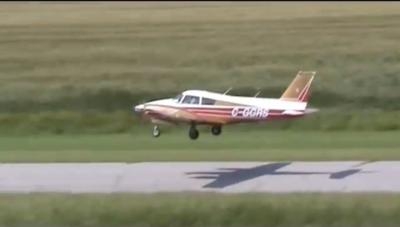Was Demonstrating Engine Restart Procedure, According To Surviving Passenger
The pilot of a Piper PA-30 Twin Comanche which went down May 27 in Alaska was trying to demonstrate an engine restart procedure, but could not get his engine to come back to life, according to a passenger who survived the accident.

In its preliminary report on the accident, the NTSB said that the aircraft collided with the ground shortly after a low-level pass over a remote airstrip at Glacier Point, 12 miles southeast of Haines, Alaska. The commercial pilot, and a pilot-rated passenger were fatally injured, and a rear-seated passenger sustained serious injuries. The aircraft was registered to the pilot, identified in FAA records as David Kunat of Juneau, AK, and operated as a personal flight under the provisions of 14 Code of Federal Regulations Part 91. Visual meteorological conditions prevailed and a flight plan was filed. The flight originated from Juneau International Airport, Juneau, Alaska, about 1015 and was destined for Haines Airport, Haines, Alaska.
An eyewitness located across Lynn Canal, about 2 miles east of Glacier Point, observed the accident airplane through binoculars, flying northbound at tree top level near the airstrip. He stated the airplane reached the end of the airstrip, descended just before it banked to the right, and subsequently impacted the shoreline in a right wing-down, nose-down attitude. The airplane came to rest near the water's edge about 1/4-mile northeast of the airstrip. The eyewitness and three other people responded to the accident site by boat. About halfway across the canal, when cell coverage was available, the witness called local authorities. The eyewitness stated that the rear-seated passenger was the only occupant that was responsive when they arrived at the accident site. The witnesses reported that impact damage prevented them from extricating the rear-seat occupant from the wreckage. Within minutes, tidal water rose and submerged the airplane. A tractor was brought to the site from a local tour facility,
and used to drag the airplane to shallow water. Local authorities arrived shortly thereafter and extricated the rear-seated passenger.

The rear-seated passenger was interviewed by the NTSB investigator-in-charge (IIC), and reported that about 20 minutes into the flight the pilot intentionally shut down the right engine and was demonstrating how to restart the engine during flight. Despite several attempts, the engine would not rotate through with electrical power to start the engine. The pilot then made several attempts to air-start the engine by gaining altitude and diving the airplane down to use airflow to assist in rotating the engine. After two unsuccessful attempts to air-start the engine, the pilot diverted to a remote gravel airstrip at Glacier Point. The witness stated the pilot intended to land at Glacier Point and use a battery booster located in the baggage compartment to start the engine. As the airplane approached the airstrip, the pilot made a low-level pass to check the conditions at the airstrip. He concluded by stating this was his last memories of the flight.
Initial examination of the airplane by the NTSB-IIC and Federal Aviation Administration inspector revealed impact damage consistent with a right wing-down, nose-down airplane attitude during ground impact. The airplane remained intact and all flight control surfaces were accounted for and cable control continuity was attained. The landing gear was in the down position and the landing gear position switch was also in the down position. The landing disengage motor-raise motor release arm was found in the disengaged position. The emergency landing gear extension handle was removed from its stowed position and installed in a socket on the emergency disengage control. The flaps were in the up position and the flap lever was in the down position. Both engines separated from their respective wing mounts and remained partially attached to the wings by control cables and tubing. The left propeller blades revealed gouging, twisting and material loss of one blade. The right propeller was found in the feathered
position with one blade bent rearward; the opposing blade that was unremarkable. The elevator trim actuator was found in the full nose-down position, and the rudder trim indicator was in the nose left position.
(Image from YouTube video posted by user AeroportStHyacinthe. Not accident airplane)
 ANN's Daily Aero-Term (05.05.24): Omnidirectional Approach Lighting System
ANN's Daily Aero-Term (05.05.24): Omnidirectional Approach Lighting System Aero-News: Quote of the Day (05.05.24)
Aero-News: Quote of the Day (05.05.24) Airborne 05.06.24: Gone West-Dick Rutan, ICON BK Update, SpaceX EVA Suit
Airborne 05.06.24: Gone West-Dick Rutan, ICON BK Update, SpaceX EVA Suit Airborne 05.03.24: Advanced Powerplant Solutions, PRA Runway Woes, Drone Racing
Airborne 05.03.24: Advanced Powerplant Solutions, PRA Runway Woes, Drone Racing Aero-News: Quote of the Day (05.06xx.24)
Aero-News: Quote of the Day (05.06xx.24)




